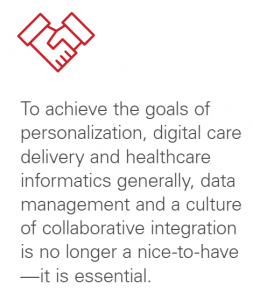My last blog in this series outlined virtual consults and the major role they play today in the patient experience. Today, I focus on the opportunities with better analytics and patient experience.
The emerging Salesforce/Cerner relationship is one of many indicators of a new paradigm in the culture of—as much as of the mechanics of—interoperability. Major players are recognizing that there is more long-term value in substantive collaboration than in simple open APIs. The industry is finally moving past the perception that owning data (or at least preferential access to data) has a value in its own right, and recognizing that value is only achievable in multi-party relationships that enable data siloes to actually merge and create new insight.
As this plays out across healthcare, it has a number of specific impacts.
First, the importance and demand for API and microservices capabilities, and for healthcare-specific capabilities in FHIR, will continue to expand rapidly. (Demand will outpace supply in this regard for some time, but healthcare technology has a habit of right-sizing quickly.)
To achieve the goals of personalization, digital care delivery and healthcare informatics generally, data management and a culture of collaborative integration is no longer a nice-to-have—it is essential. Organizations that recognize this dynamic and promote a culture of collaboration internally, as well as in their interactions with other entities, will be well positioned.
Secondly, and more speculatively, this is obviously one of the areas where blockchain use cases may ultimately be proven out in healthcare, but it is by no means the panacea some thought it would be—yet. This is precisely because it still relies on the same issue: a culture of actual collaboration between distinct entities for a common, commonly defined, goal—with no opt-outs—to be effective. That is easier said than done, especially in the fragmented, competitive-to-a-fault, healthcare world from which we are trying to evolve.
Yes, the outcome of this trend will be felt in substantial improvements in the quality of analytics and resultant insight for health systems, but more importantly, it will be felt in the personalized patient/consumer experience that finally begins to match other industries. Much has been made of the “creepiness” factor in personalized healthcare interactions (for example, a family
inadvertently learning of a sensitive issue affecting an adolescent child by virtue of personalized content). The only way to address these issues will be through the deployment of more sophisticated personalization protocols which are, of course, dependent upon better data. 
Questions to Consider
- Is your organization optimized from a technology perspective for collaborative data sharing between environments to drive net new insight?
- Is your organization optimized from a culture perspective for collaborative data sharing between environments to drive net new insight?
- How effectively does your organization partner with third parties from both a technology and culture perspective? Are you limited by your appetite for risk or by a lack of viable use cases for collaboration?
To learn more about the top five digital health trends for providers, you can click here or download the guide below.

